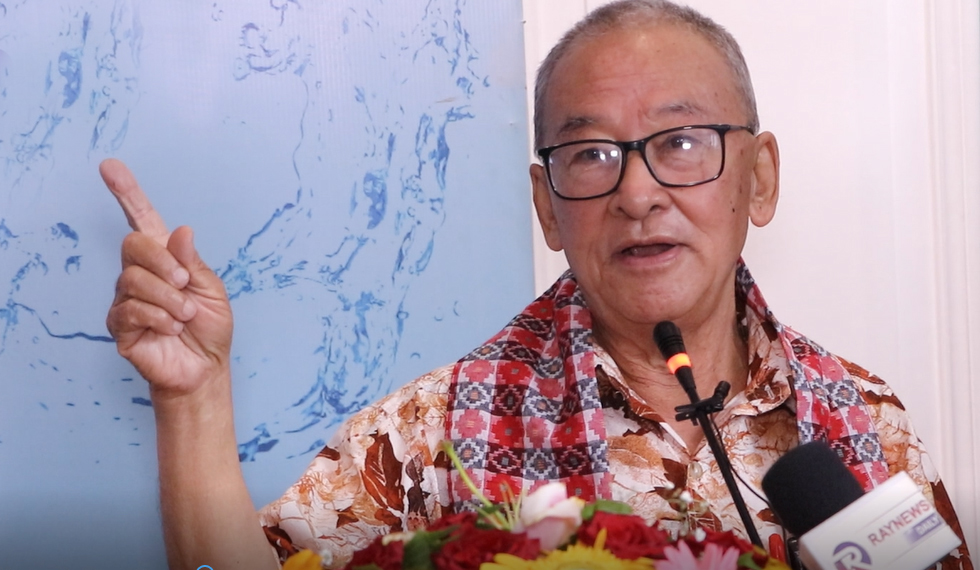Asian Water Resources, Regional Cooperation and Nepal
- Hiranyalal Shrestha

Kathmandu 2021 September 11, Saturday
– Hiranyalal Shrestha,
More than two-thirds of the world we live in is covered by water. However, more than two-thirds of the world’s population is deprived of adequate and clean drinking water because 97 percent of the water in the oceans and seas is salty and not drinkable. Only 3 percent of the world’s water is drinkable. Of that, 2 percent is in the form of snow and glaciers. In fact, only one percent of the water is clean, tidy and usable.
People cannot live without water. There are many options for generating electricity. Hydropower, solar, nuclear, wind etc. but there is no alternative to water. But water consumption is increasing. Gradually becoming inadequate, destitute and expensive. Therefore, the controversy over water is growing all over the world. There is a debate over who will capture the water source and how. The new source of conflict in the world will be the water dispute.
Water resources in Asia
It is a historical fact that the ancient civilizations and major settlements of Asia has developed along the banks of the great rivers. Large water resources projects have been constructed and implemented using modern science and technology to modernize the water resources sector. Rivers and lakes are the basis of Asia’s prosperity. There are more than 50 rivers in Bangladesh. There are 4 major rivers in Bhutan, 400 in India, 200 in Indonesia, 108 in Japan, 1 in Laos, 10 in Korea, 5 in Singapore, 10 in Thailand and 4 in Nepal. China has the largest water resources. The seven major rivers in China are the Yangtze, Yellow, Pearl, Huway, Haihe, Songjujiang and Liahe.
Tibet is the source of major rivers in Asia
China’s Tibet Autonomous Region is the source of six major rivers in Asia. Forty-six percent of the world’s population depends on rivers flowing through Tibet. The rivers Indus, Ganga, Brahmaputra, Irawati, Salbin and Mekong originate from Tibet. As the source of Tibet’s major rivers in Asia, China is Asia’s leading source of water and has the potential to control and develop water supplies in South and Southeast Asia. Some countries in the West and the South are doing the wrong thing by inciting separatists in Tibet.
The Mekong River Regional Cooperation is Remarkable
The Mekong River, which originates in China, is the longest river in Southeast Asia. It is also the seventh longest river in Asia and the twelfth longest in the world. The 2,700-mile-long Mekong River flows through China, Myanmar, Laos, Thailand, Cambodia, and Vietnam into South China Sea. In 2016, the above six countries established the Mekong River Regional Cooperation.
It is characterized by joint efforts in multi-dimensional water use including flood control, hydropower generation, irrigation and waterways. The United States is pursuing an Asia-Pacific strategy that seeks to undermine the Mekong.
Nepal’s perspective on water resources
ISIMOD’s 2001 report states: “Water is Nepal’s largest natural resource. There are more than six thousand rivers in Nepal. The water flowing from the mountains during the dry season is estimated at 4,930 cubic liters per second per year. It makes up 70 percent of the total water flowing from the surface. Despite being rich in water, Nepal has not been able to use it enough for itself. ‘
In Nepal, in 1911, the first hydropower plant in Pharping was built at 500 K. This is the first hydropower project in Nepal and the second in Asia. In B.S.1980, Nepal’s first modern canal, the Chandranhar, was built in Saptari. When Nepal lost to India in 1920, the dam agreement was signed in 1954. Ma Koshi Yojana, 1959 AD. The Gandak Agreement and the 1996 AD. Mahakali agreement was reached
. From Sarada Dam India 14,000 cusecs and Nepal 460 cusecs (3.97% ratio), from Koshi India 236,000 cusecs and Nepal 1600 cusecs (ratio of 6.5 and 93.5%), in Gandak agreement India 29,000 cusecs and Nepal has unequally distributed 850 cusecs (3.57%) of water. Even though the border river is said to be similar in the Mahakali treaty, the Pancheshwor DPR has not been prepared yet due to India’s pressure to draw more water under the pretext of advance consumption.
Call for regional cooperation
Nepal, which has a bitter experience in the field of bilateral water resources, on December 5, 1977 called for regional cooperation in the field of water resources. Inaugurating the meeting of the 26th Consultative Committee of the Colombo Plan, King Birendra said, “Although water resources may be an important tool for Nepal’s economic development, we do not intend to view it only from the perspective of our national interest.”
We believe that our allies, especially Nepal, India, Bhutan, Bangladesh, Pakistan, Sri Lanka and all other countries in the region, can use such innumerable natural resources for the benefit of all countries in the region.
Water resources in SAARC and BIMSTEC
Ministers of the eight countries signed the SAARC Regional Cooperation Framework Agreement for Energy Cooperation on November 27, 2014 in Kathmandu with the South Asian Association for Regional Cooperation (SAARC) member states Afghanistan, Bangladesh, Bhutan, India, Maldives, Nepal, Pakistan and Sri Lanka. It mentions the construction of regional transmission lines and the growth of pure trade.
It is also mentioned that the Bay of Bengal Initiative for Multilateral Technical and Economic Cooperation will provide assistance in 14 thematic areas of energy such as energy, fisheries, agriculture and environment. Bangladesh has repeatedly sent proposals to buy Nepal’s electricity, invest in the water resources sector. Therefore, Nepal has a clear vision to increase mutual cooperation in the field of water resources at the regional and sub-regional levels.
Nepal-China water resources
Nepal and China are connected by rivers, mountains, hills and mountains, have been close friends since prehistoric times. In terms of water resources, both are coastal countries with the same watershed. The two countries have a common concern for the environment of the Himalayas, snow and glaciers in the middle of China’s Tibet Autonomous Region.
China’s government and non-government sectors have been contributing to the development of Nepal’s water resources with deep interest. Winter and shift environment is connected. The two countries need to work together to mitigate the adverse effects of climate change. Just as China and Southeast Asia have made joint efforts in regional cooperation on the Mekong River, China should also be involved as a partner in the development of South Asia’s water resources.
Challenges of regional cooperation
The prosperity of the countries of South and East Asia is possible only through the mutual cooperation of the countries of this region.However, other countries and external interventions in this area are the biggest challenge to our cooperation. Countries in the region are strong in terms of natural resources, human resources, economic and all other capabilities. Though, due to external interference, mutual cooperation has not been possible here. The big countries including the United States have been raising various issues from time to time to prevent mutual cooperation and to keep Asia behind.
In the policy of divide and rule, they sometimes raise many issues like the rights of a country, the civil rights of that country, human rights, education, health, security. Ultimately, the bottom of all this is to suppress the prosperity of South and East Asia. It is to stop mutual cooperation. Hiranya Lal Shrestha an expert said, ‘The biggest challenges are the US-led Indo-Pacific Strategy, the MCC, the Tibet Policy and the Cooperation Act. Western nations, including the United States want to keep Tibet under siege forever.’
We must break this and maintain strong unity. Poverty, illiteracy and instability are another challenge. We can solve these challenges together. Section 343 of the Tibet Policy and Assistance Act states that “China accounts for a small percentage of the world’s population. However, only a very small percentage of the world’s potable water is available for use. Many countries in Southeast Asia have severe water shortages. ”
This makes it clear that the United States has directly claimed the water resources in Tibet by saying for the world’s population. Most of the major rivers in South and East Asia have their source in Tibet. It is a naked intervention for one country to claim the natural resources of another country in such a way, to make laws and claim the resources of another country for the rights of the world’s population. United States will make similar claims on Nepal’s rivers in future.
It makes similar claims over other countries. This policy is ultimately a threat to the world. Such policies of the expansionist countries, including the United States, divide and rule to prevent the development and mutual cooperation of Southeast Asia. United States has claimed not only the water resources in Tibet but also the rivers in Southeast Asia under Section 343 of the Tibet Policy and Assistance Act. Section 343 of the Act mentions the Mekong River, a source in the Tibetan land.
The Mekong River flows through China, Vietnam, Cambodia, Laos, and Thailand. The countries concerned with this river have been very effective in developing the Mekong River Area Cooperation Plan in this area. However, out of fear of that, the United States has put forward an interventionist policy through this act.’ It is also an intervention in another country and in Southeast Asia. It is an attempt to disrupt cooperation between Southeast Asian countries.
Summary
The Sindhu, Ganga and Brahmaputra rivers should be given the status of international rivers. This water resource should be taken forward by all the coastal countries (including China) towards greater regional cooperation (in the Mekong model). Incessant waterways should be opened. Electricity transmission lines should be connected to each other. Thus, joint efforts in water resources development must continue to make the 21st century the century of Asia.
(Hiranya Lal Shrestha is a senior writer and Diplomat)










